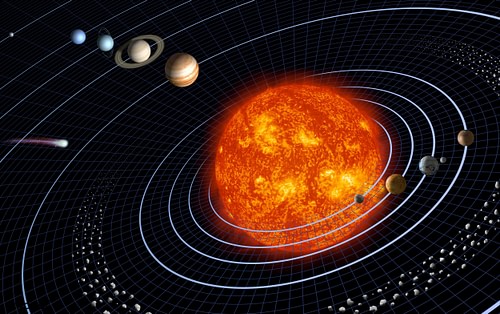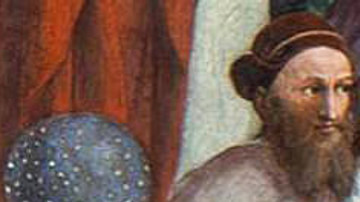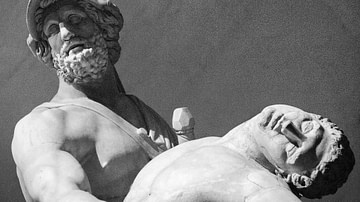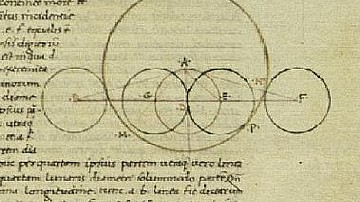
Nicolaus Copernicus (1473-1543 CE) was a Polish astronomer who famously proposed that the Earth and other planets revolved around the Sun in a heliocentric system and not, as then widely thought, in a geocentric system where the Earth is the centre.
Copernicus’ heliocentric theory was not entirely a new idea as several earlier scholars had proposed a heliocentric system, but Copernicus additionally theorised a new order for the planets in terms of their distance from the Sun, that the Earth orbits the Sun once every year, and that the Earth turns entirely on its own axis each day. These ideas were contrary to those of the Catholic Church which considered humanity and the Earth as the proper and actual centre of God's universe. The reaction to Copernicus' major work, De Revolutionibus Orbium Coelestium (On the Revolutions of the Heavenly Spheres), published in the year he died, was muted, and there was hardly a revolutionary overturning of how everyone saw the world's place in the universe, as is often claimed. Nevertheless, the astronomer's work would slowly lead to further investigations by later scientists and mathematicians who eventually proved that Copernicus' heliocentric system with a spinning Earth, although containing flaws, was essentially correct.
Early Life
Nicolaus Copernicus, real name Mikołaj Kopernik, was born on 19 February 1473 CE in Toruń, Poland (then part of Prussia). His father was a successful merchant but after his death c. 1483 CE Copernicus was adopted by Lucas Watzelrode, his maternal uncle. Significantly, Watzelrode later became bishop of Warmia, and the young Nicolaus was likewise expected to pursue a career in the church. First, though, he studied astronomy at the University of Kraków and then medicine and astrology at the University of Bologna. His wide-ranging education in the liberal arts also included mathematics, philosophy, and history. His travels continued when he lectured in mathematics in Rome in 1500 CE, after which he went to the University of Padua to continue his medical studies. Finally, in 1503 CE, he received a doctorate in canon law from the University of Ferrara. This broad education would serve him well for his future investigations, but it is perhaps the astrological observations he made while in Bologna which really set his mind towards solving the problems of the heavenly bodies and their movements.
Copernicus returned to Poland in 1506 CE where he acted as his uncle's physician. His uncle also set him up as a church canon (although he never became a priest), a position which required him to collect the rents, manage the assets and oversee the finances of the bishopric of Frombork (aka Frauenburg). Despite these worldly duties, Copernicus never forgot astronomy, and he continued to pursue this field of study in his free time.
Observing the Skies
In his studies of the heavens, Copernicus had to wrestle with several problems that divided opinions amongst astronomers. There was the persistent idea, first proposed by Aristotle (384-322 BCE), that the planets moved in a uniform way through an undefined medium of invisible spheres, always at fixed distances from a central point, the Earth. This means that the universe must be made up of a series of concentric spheres. Unfortunately, this theory did not match the experience of viewing a variation in the brightness of planets in the night sky. How, then, could planets always be the same distance from the Earth?
There was another age-old and related problem in the field, this time a consequence of the theories of Claudius Ptolemy (c. 100 - c. 170 CE). Ptolemy proposed that planets moved within a small circular orbit of their own (epicycle) while still following a larger orbit (deferent) around a fixed central point, the Earth (equant) or, for Ptolemy, a point slightly away from it. The problem with this theory is that it went against the traditional and seemingly untouchable idea that planets moved uniformly and at a constant distance from the Earth in a circular orbit. If one put together Aristotle's scheme of concentric spheres and Ptolemy's scheme of orbits within orbits, then the spheres which contained the planets would wobble and at some point collide - not a possibility for an ordered universe. In the 13th century CE, Persian astronomers attempted to solve this conundrum by combining two epicycles which uniformly revolve around each other. This would create an oscillating point and explain why planets changed distance from the Earth. Copernicus knew of and studied all of these theories, but their complexity seemed contrived to explain an original model that was perhaps itself flawed. Change the central equant point and perhaps the physical behaviour of the planets would become clearer, and the theory that explained it a whole lot simpler.
The Heliocentric Solution
Copernicus worked for three decades on his theories of just how the Earth and those heavenly bodies visible in the night sky were related to each other. The telescope had not yet been invented, but by observing lunar eclipses and the movement of planets and constellations, he eventually came up with an explanation for the things he saw, perhaps by around 1514 CE. In addition, Copernicus used many observations from past astronomers, some of which were not wholly accurate.

That Copernicus was active and respected in the field of astronomy is evidenced by the invitation in 1514 CE to attend the Fifth Lateran Council. There he was to present his views on the proposed reforms to the calendar, important for Church holy days but now long out of synch with the position of the Sun on any given day. In the event, the famous astronomer never attended.
The final result of his research was nothing short of mind-blowing for the European academic community and especially the hierarchy of the Catholic Church. Copernicus proposed that the central point of the universe was not the Earth with all other bodies revolving around it. Rather, the Earth was a planet, which orbited around the Sun, the real central point of our solar system. So, too, it was not the celestial bodies like Mars, Venus, and the stars that revolved around the Earth but the Earth turning on its own axis and orbiting around the Sun, which explained their movements across the sky in a single night and over the period of a year. Further, Copernicus suggested that the Earth made a single turn on its axis in a day and took one year to orbit around the Sun. In addition, relatively small changes in the angle of the Earth's axis over time explained the precession of the equinoxes, that is, the gradual shifting of the constellations in the night sky over time, a phenomenon known since antiquity.
The reason why such visible planets as Mercury and Venus showed only a small motion in the night sky was because they orbited within the Earth's orbit of the Sun. Likewise, the often strange motions of the planets Mars, Jupiter, and Saturn could now be explained as due to their position beyond Earth's orbit where they revolved around the Sun at a slower rate. Copernicus was thus able to show that the then observable planets were in the following order from the Sun: Mercury, Venus, Earth, Mars, Jupiter, and Saturn. All of these radical ideas were presented in Copernicus' De Revolutionibus Orbium Coelestium (On the Revolutions of the Heavenly Spheres), a work of six volumes not actually published until 1543 CE. The delay might have been due to the author's concern for the public's reaction, but it is much more likely that he was still wrestling with details and problems of mathematics. Indeed, Copernicus himself stated that he was a mathematician writing for mathematicians, and few outside the field would have understood its contents. The change in the original title, replacing 'Spheres of the World' for 'Heavenly Spheres', does suggest the author was trying to minimise the focus on the real world and concentrate on theoretical mathematics.
The Reaction to De Revolutionibus
There were still quite a few problems to deal with, though. Copernicus' theory had done away with the prevailing explanation for the observable phenomenon of gravity, i.e. things fell to the ground because the Earth was at the centre of the universe. Another problem was that Copernicus still did not realise the planetary orbits were not perfect circles. That the orbits were elliptical was later formulated by the German astronomer Johannes Kepler (1571-1630 CE).
Even more problematic than these questions of physics, Copernicus' ideas went wholly against the traditional view of humanity's place in the universe as proposed by the Catholic Church. The idea that the Earth was the central point and the Sun and Moon orbited around it (the anthropocentric model) was in keeping with the idea that humanity was also the focus, indeed, the whole point of the universe's existence as created by God. The idea that the Earth was the centre of the known universe went back to antiquity and was difficult to shift (even if some ancient thinkers had proposed a heliocentric system).
Fortunately for Copernicus, although it happened without his permission, Andreas Osiander (1498–1552 CE), the Lutheran minister who had supervised the publication of De Revolutionibus, had inserted a preface which stated the work was intended as a theoretical aid to mathematicians and not a presentation of how the universe was in reality. This view was in keeping with the times as astronomy and mathematics were regarded as theoretical subjects. Such work as the De Revolutionibus could not seriously attempt to change the general view of the physical world as that was then considered a task for natural philosophy. The preface and traditional separation of academic subjects at the time may well have saved the work and Copernicus' memory - he had died in Frombork shortly before publication on 24 May 1543 CE - from the full wrath of the Catholic Church.
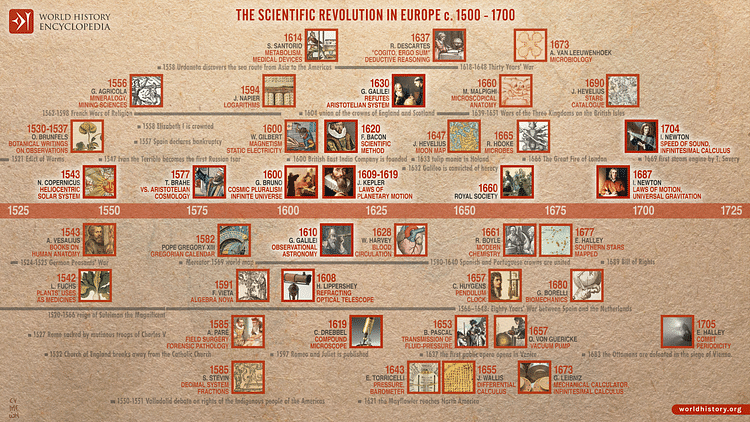
Legacy
As it happened, reaction to Copernicus' theory was rather tame all round, and even the small pool of astronomy scholars who were its intended audience measured barely a ripple of reaction. However, it was a slow-burner and as later scientists began to explore the same themes and seek ever more accurate astronomical tables, so Copernicus' work came to the fore a few years after its publication. So much so, the reformist Martin Luther (1483-1546 CE) denounced the De Revolutionibus. By 1616 CE, it was more widely known and condemned as heretical by Church authorities who listed it as a forbidden book.
Despite Christianity's attempt to brush Copernicus' theories under the ecclesiastical carpet, his work began a long process of scientifically determining the nature of our solar system and its place in the wider universe. Over the following centuries, great thinkers like Galileo (1564-1642 CE) and Isaac Newton (1642-1727 CE) would add to an ever-growing body of knowledge regarding the movement and properties of planets, moons, and stars. In this sense, Copernicus was one of the first protagonists in the scientific revolution that began in the Renaissance period. In honour of his contribution to this process and modern astronomy, one of the largest craters on the Moon is named after Copernicus.
